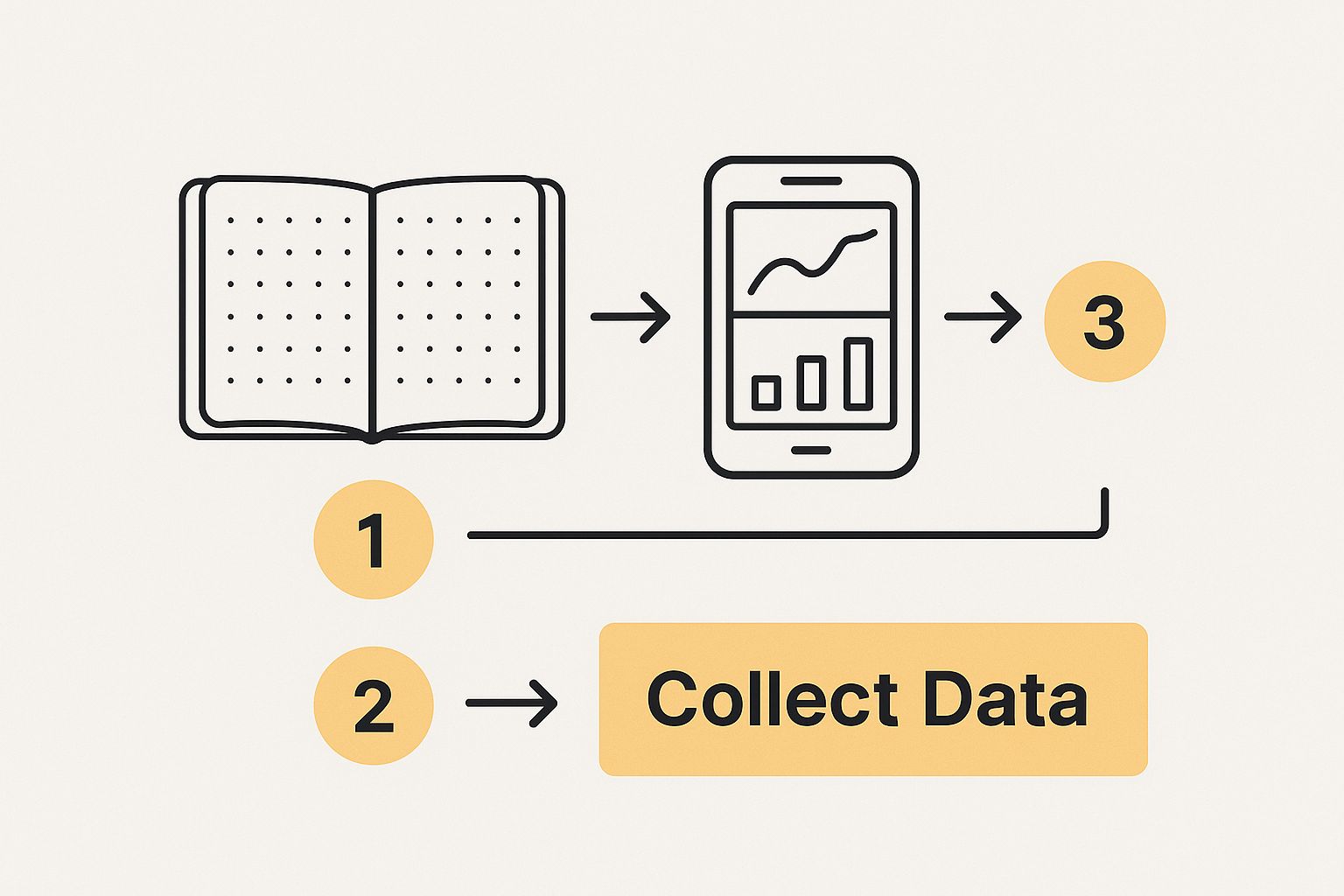You can't just jump into competitor analysis without a game plan. The whole point is to get answers, so you have to start by asking the right questions. This means figuring out your goals, identifying who you're really up against, and picking the right tools to get the data you need.
It’s a methodical look at your competitors' marketing, their products, and what their customers are saying about them. Done right, it reveals strategic opportunities you'd otherwise miss.
Why Competitor Analysis Is Your Strategic Compass
Let's get one thing straight: this isn't about "spying" on your rivals. Think of it more as a core business discipline—the intelligence you need to navigate your market without flying blind. It’s less about copying what others are doing and more about understanding the competitive landscape so you can make smarter, proactive decisions.
Without it, you're constantly reacting. With it, you start anticipating.
The goal is to build an ongoing intelligence loop that keeps feeding your growth strategy. The businesses that actually commit to this see real, tangible benefits.
Uncover Market Gaps and Opportunities
A deep dive into your competitors shows you what they aren't doing. For example, maybe you discover that every major player in your space targets enterprise clients, leaving a massive opening for a solution built specifically for small businesses.
Or perhaps you notice their customer reviews are riddled with complaints about a missing feature. That's a huge signal for your own product roadmap. These are the underserved needs that lead to breakthroughs.
By systematically checking out your rivals, you stop making assumptions and start making decisions backed by actual data. It’s the difference between guessing what customers want and knowing what the market is asking for but not getting.
Refine Your Unique Value Proposition
Understanding how competitors position themselves helps you figure out what makes you different. If everyone else is in a race to the bottom on price, maybe you can stand out by focusing on superior customer service or product quality.
This kind of clarity is gold when you're crafting marketing messages. It helps you speak directly to your target audience and tell them exactly why they should choose you.
This isn't some niche activity, either. The value of this kind of strategic work is getting more and more recognized. The global market for Competitor Analysis Evaluation services was valued at roughly $4.32 billion in 2021 and is on track to hit about $6.6 billion by 2025.
You can check out the full competitor analysis market report to see the trends for yourself. This growth shows just how seriously businesses are taking this kind of strategic work to maintain their edge.
Defining Your Goals and Identifying True Competitors

Jumping into a competitor analysis without clear goals is like starting a road trip with no destination. You'll gather tons of information, sure, but none of it will get you where you need to be. A good analysis always starts with knowing exactly what you're trying to achieve.
Are you trying to spot gaps in a rival's product features? Or maybe you need to benchmark your pricing to see if you’re even in the right ballpark. Your objective shapes the entire process, dictating the data you'll hunt for and the tools you'll need.
Before you even think about looking at other companies, get your own objectives straight. And make them specific. Vague goals like "see what competitors are doing on social media" are a waste of time.
A much better goal would be something concrete, like: "Identify the top three content themes our main competitor uses on Instagram that consistently generate over 1,000 likes per post." Now that gives you a clear target and a measurable outcome.
Distinguishing Between Competitor Types
Once your goals are locked in, the next step is figuring out who you're actually up against. It's surprisingly easy to get this wrong by only focusing on the obvious players. To make sure you're analyzing the right businesses, it’s critical to understand how to find competitors of a website.
You need to look beyond the surface and sort your rivals into a few key categories. This helps you prioritize your efforts and understand different kinds of market pressure.
- Direct Competitors: These are the businesses selling a nearly identical product or service to the same people you are. For a local coffee shop, this is the cafe right across the street. Simple.
- Indirect Competitors: These companies solve the same customer problem, but with a totally different solution. That same coffee shop isn't just up against other cafes; it's also competing with the energy drink aisle at the grocery store.
- Emerging Competitors: These are the newcomers and disruptors. They might not have a huge market share yet, but they're gaining ground fast. Ignoring them is a classic mistake that leaves established businesses vulnerable.
This process isn't just about making a list. It's about understanding how each type of competitor impacts your business differently. A direct competitor might force you to adjust pricing, while an indirect one could signal a major shift in what customers want.
Identifying these different players is impossible without a crystal-clear picture of your ideal customers. If you haven't already, now is the perfect time to nail down your customer profiles. Learning how to create buyer personas will guide your entire research process, making sure your analysis stays focused on the rivals that truly matter to your audience.
Building Your Competitor Intelligence Toolkit
Let’s be honest: manually scraping competitor websites and social media feeds is a recipe for burnout. It’s a slow, painful process that almost guarantees you’ll miss crucial information. To do this right, you need a modern toolkit designed to gather and organize intelligence efficiently.
The goal isn't to subscribe to every flashy platform out there. It’s about being strategic. You need to pick the right tools to answer the specific questions you defined in the first step. A well-curated toolkit gives you the power to see what’s working for others and, more importantly, where their weaknesses are.
Choosing the Right Tools for the Job
Your toolkit should cover a few key areas of your competitors' operations. Think of it less like a random collection of software and more like assembling a specialized team, where each tool has a distinct role. Today’s analysis relies on tools like Semrush, Ahrefs, and Similarweb that offer deep dives into SEO strategies, website traffic, and audience demographics. These platforms don’t just track what your competitors are doing; they help you understand why it's working (or not).
A solid starting point includes tools that cover:
- SEO and Content Performance: To see which keywords they rank for, where their backlinks come from, and what content drives their traffic.
- Social Media Engagement: To track their audience growth, engagement rates, and top-performing posts.
- Website Traffic and Demographics: To estimate their overall site traffic, identify their primary traffic sources, and understand who their audience is.
The right technology makes systematic data collection manageable, which is always the first step in any real analysis.

A Practical Scenario in Action
Let's say you want to deconstruct a competitor's content strategy. Instead of spending hours manually scrolling through their blog, you could use an SEO tool like Ahrefs to instantly pull a report of their top-performing articles by organic traffic.
This report doesn't just give you a list of titles. It reveals the specific keywords each article ranks for and the number of backlinks pointing to it. Suddenly, you have a clear blueprint of their most successful content pillars. You can see which topics are resonating with their audience and which articles have earned the most authority in your niche.
This approach moves you from guessing what works to knowing what works. You can identify high-value "keyword gaps"—topics your competitor ranks for that you haven’t covered—giving you a direct path to creating content with a proven demand.
To help you get started, here's a breakdown of popular competitor analysis tools, their primary functions, and ideal use cases to help you build your intelligence stack.
Competitor Analysis Tool Comparison
| Tool Category | Example Tools | Primary Use Case | Key Metrics to Track |
|---|---|---|---|
| SEO & Content | Semrush, Ahrefs, Moz Pro | Analyzing organic search performance, backlink profiles, and top content. | Organic Keywords, Domain Authority, Backlinks, Top Pages, Keyword Gaps |
| Website Traffic | Similarweb, Alexa | Estimating website traffic, audience demographics, and traffic sources. | Total Visits, Bounce Rate, Traffic Sources (Direct, Referral, Search), Audience Geo |
| Social Media | Sprout Social, Brandwatch | Monitoring social media engagement, audience growth, and sentiment. | Engagement Rate, Follower Growth, Mentions, Share of Voice, Top Posts |
| Ad Intelligence | SpyFu, AdBeat | Uncovering competitor advertising strategies, ad copy, and budgets. | Ad Spend, Top Keywords, Ad Copy, Landing Pages, Ad Networks |
Building a robust toolkit is crucial for gathering this information effectively. By leveraging some of the leading social media competitor analysis tools and combining those insights with data from SEO platforms and traffic estimators, you start to build a 360-degree view of your competitive landscape.
This comprehensive picture is what allows you to stop reacting and start making smarter, data-driven decisions for your own strategy.
Finding Actionable Insights Hidden in the Data

All that data you've gathered? Right now, it's just a pile of numbers and links. The real magic happens when you start connecting the dots and turning that raw information into a story—a story that shows you exactly where you can win.
Your job isn't just to note facts. It's to hunt for patterns and constantly ask, "Why?" Why did they suddenly start bidding on a whole new set of keywords? What was behind that social media engagement spike last month? The answers are where your strategy begins.
For example, you might see a competitor suddenly ranking for a bunch of "AI-powered automation" keywords. That's more than just an SEO metric. If you pair that discovery with their recent product updates and new job postings for machine learning engineers, a clear picture starts to form. They're making a serious strategic push into a new market, and now you have the intel to react.
Analyzing the Marketing Mix
A competitor's marketing mix is a goldmine. It tells you who they're trying to reach, how they talk to them, and where they're putting their money. The key is to look at how all their channels work together, not just in isolation.
Start by breaking down their main channels and figuring out the strategy for each.
- Content Marketing: Are they publishing massive, in-depth blog posts, or are they all-in on short-form video? Maybe they focus on detailed case studies. This tells you a ton about their target audience's sophistication and what kind of information they actually value.
- Paid Advertising: Check out the ad copy and visuals on platforms like Google Ads or Facebook. Are they pushing a free trial, a big discount, or an educational webinar? You’ll get a clear read on their customer acquisition funnel.
- Social Media Presence: Note which platforms they actually use and the tone of their messaging. A heavy presence on LinkedIn screams B2B focus, while a creative TikTok strategy probably points to a younger, consumer-facing audience.
The goal is to move past simple observation. Don't just say, "They post on Instagram three times a week." The real insight is, "They're using Instagram to build brand affinity with a younger demographic through user-generated content—a channel we're completely ignoring."
Uncovering Product and Customer Sentiment Insights
Your analysis can't stop at marketing. Digging into their product and what customers are saying can reveal huge vulnerabilities you can pounce on. This is where you find out what people really think.
Go comb through customer reviews on sites like G2, Capterra, or even their own Google Business Profile. Look for themes that pop up again and again, in both the good and the bad feedback. Consistent complaints about terrible customer service or a clunky UI are weaknesses you can build a marketing campaign around.
You should also look at their product features and how often they release updates. If they're constantly launching new features but customer reviews show nobody's using them, they might be building solutions for problems that don't exist. That's a critical insight, highlighting a gap between their product roadmap and what customers actually need. This kind of targeted intelligence is especially powerful for smaller companies; our guide on data analytics for small business digs deeper into turning this kind of data into smart decisions.
This level of detailed insight is only getting more important. By 2025, the global market research industry is projected to hit $150 billion, all driven by the demand for real-time, predictive insights. This massive growth just proves how critical it is to use sharp analytics to understand your competitive environment. You can discover more about future competitor intelligence trends to see how technology is shaping this field.
Translating Your Analysis into a Winning Strategy
All the data you’ve gathered is useless if it just sits in a spreadsheet. This is where the real work begins—turning those raw insights into a clear, actionable plan that actually gives you an edge.
Frankly, an analysis that doesn't lead to action is just a waste of time. The goal is to shift from just knowing what your competitors are doing to deciding what you're going to do about it. A powerful way to frame this thinking is with a classic SWOT analysis.
Conducting a Practical SWOT Analysis
SWOT stands for Strengths, Weaknesses, Opportunities, and Threats. It's been around forever for a reason—it forces you to look at your business from both an internal and external perspective, using your competitor data as the main lens.
- Strengths: Where do you have a clear advantage? This is all about your internal capabilities. Maybe your customer service is legendary, or your product is built with far superior materials.
- Weaknesses: Let’s be honest—where do your competitors have you beat? Perhaps their website is noticeably faster, or they’ve built a massive, engaged social media following you can't touch yet.
- Opportunities: What external gaps can you exploit? Your research might reveal that no one in your industry offers a flexible subscription model, or there's a new customer segment everyone is ignoring.
- Threats: What’s on the horizon that could hurt you? This could be a disruptive new competitor, a major shift in Google's algorithm, or a change in consumer behavior.
This simple framework helps you translate all that research into strategic priorities. Every weakness you identify is a problem to solve, and every opportunity is a potential project to launch.
Turning Insights into Specific Actions
Once your SWOT is filled out, the next step is to brainstorm specific actions for each point. This is where you connect your findings to real-world business decisions.
Let's walk through a quick scenario. Imagine your analysis uncovered a few key things:
- (Competitor Weakness): Your main rival’s customer support has an average response time of 48 hours, and you've seen online reviews complaining about it.
- (Market Opportunity): You notice a growing demand for eco-friendly packaging in your industry, but none of your top competitors are highlighting their sustainability efforts.
Right there, you have the seeds of an action plan.
Your next marketing campaign could heavily feature your "Under 2-Hour Support Guarantee," directly targeting a known pain point with your competitor's customers. At the same time, you could spin up a new landing page all about your sustainable sourcing and packaging to attract that underserved market segment.
This process ensures every strategic move you make is backed by solid evidence from your competitor research, not just a gut feeling.
Building Your Action Plan
The final piece is organizing these ideas into a formal action plan. For each initiative, you need to define who's doing what, by when, and how you'll know if it worked.
A simple table is often the best way to keep things organized and create accountability.
| Initiative | Key Action | Owner | Timeline | Success Metric |
|---|---|---|---|---|
| Capitalize on Slow Support | Launch "Rapid Support" campaign | Marketing Team | Q3 | 20% increase in lead form submissions |
| Seize Green Opportunity | Create sustainability landing page | Content Team | July | Rank in top 10 for "eco-friendly [product]" |
By assigning owners, setting deadlines, and defining success, you create a real sense of urgency and clarity. This structure makes it much easier to track progress and prove the value of your efforts. Understanding how to measure ROI is critical here, as it connects these strategic actions directly to your bottom line.
Common Questions About Competitor Analysis
As you start weaving competitor analysis into your regular strategy, you're going to bump into some practical questions. Happens to everyone. Getting a handle on these common hurdles is the key to building a repeatable process that actually delivers results instead of just gathering dust.
How Often Should I Run a Competitor Analysis?
This is probably the number one question I get. The honest answer? There’s no magic number, but a balanced rhythm works best.
Think of it this way: aim for a comprehensive, deep-dive analysis quarterly. This is your big-picture check-in.
But you also need lighter, ongoing monitoring. For your top three rivals, set up dashboards and alerts to track things week-to-week. You want to know about brand mentions, new backlinks, or major content pushes as they happen. This keeps you in the loop without a massive time sink every Monday morning.
A full analysis becomes non-negotiable when you’re about to make a big move.
- Launching a new product or service? You have to know what you're walking into.
- Entering a new market? The competitive landscape in a new city or demographic is a whole different ballgame.
- Seeing a competitor make a splash? If a rival suddenly overhauls their pricing or drops a huge campaign, it's time to dig in and understand why.
What Are the Most Important Metrics to Track?
Don't fall into the trap of tracking everything. The most critical metrics are the ones tied directly to your goals. Be selective, not exhaustive.
If your main objective is to climb the SEO ladder, you should be laser-focused on things like organic keyword rankings, backlink growth, and domain authority.
But if you're trying to figure out their social media secret sauce, you'll care a lot more about engagement rates, audience growth, and share of voice. For a product-focused analysis, I'd be looking at customer review ratings, how often they release new features, and any pricing shifts.
Before you even open a spreadsheet, define the one thing you want to learn from this analysis. Then, pick three to five KPIs that directly measure success for that specific goal. This is how you avoid getting lost in a sea of irrelevant data.
Is It Ethical to Analyze Competitors?
Yes, absolutely. Let’s clear this up right away. Doing a competitor analysis is not only ethical, it's a standard and necessary part of running a smart business.
The key is sticking to publicly available information. Everything on their website, their social media profiles, press releases, blog content, and even job postings is completely fair game. You're just gathering public intelligence.
Where do you cross the line? When you try to get proprietary information through shady or illegal methods. We're talking corporate espionage, misrepresenting who you are, or hacking. As long as you stick to public data sources and legitimate tools, your analysis is well within ethical boundaries.
At Up North Media, we transform competitive insights into powerful growth strategies. From data-driven SEO to custom web app development, we help Omaha businesses build a durable competitive edge. Schedule your free consultation today and see how we can accelerate your revenue.
